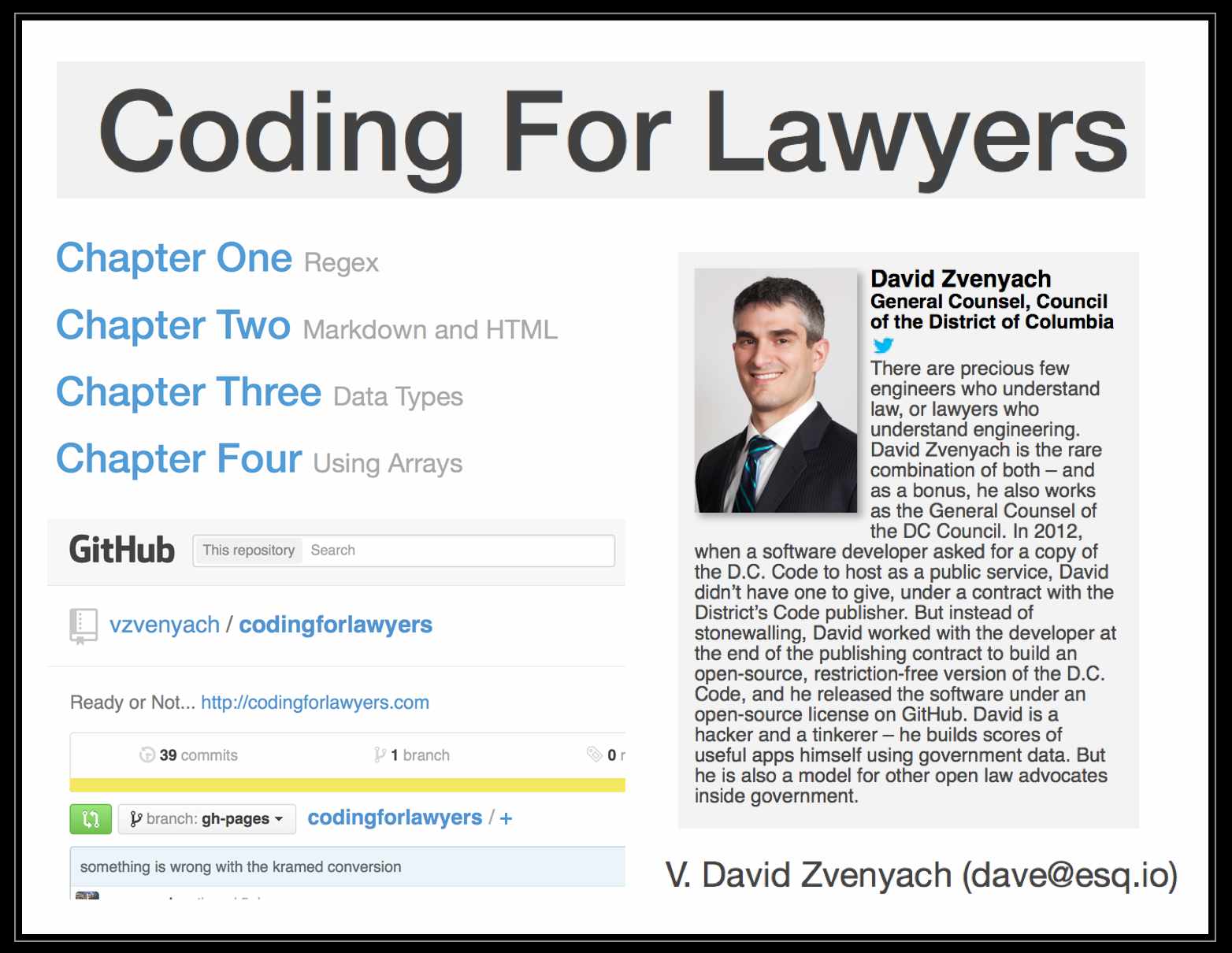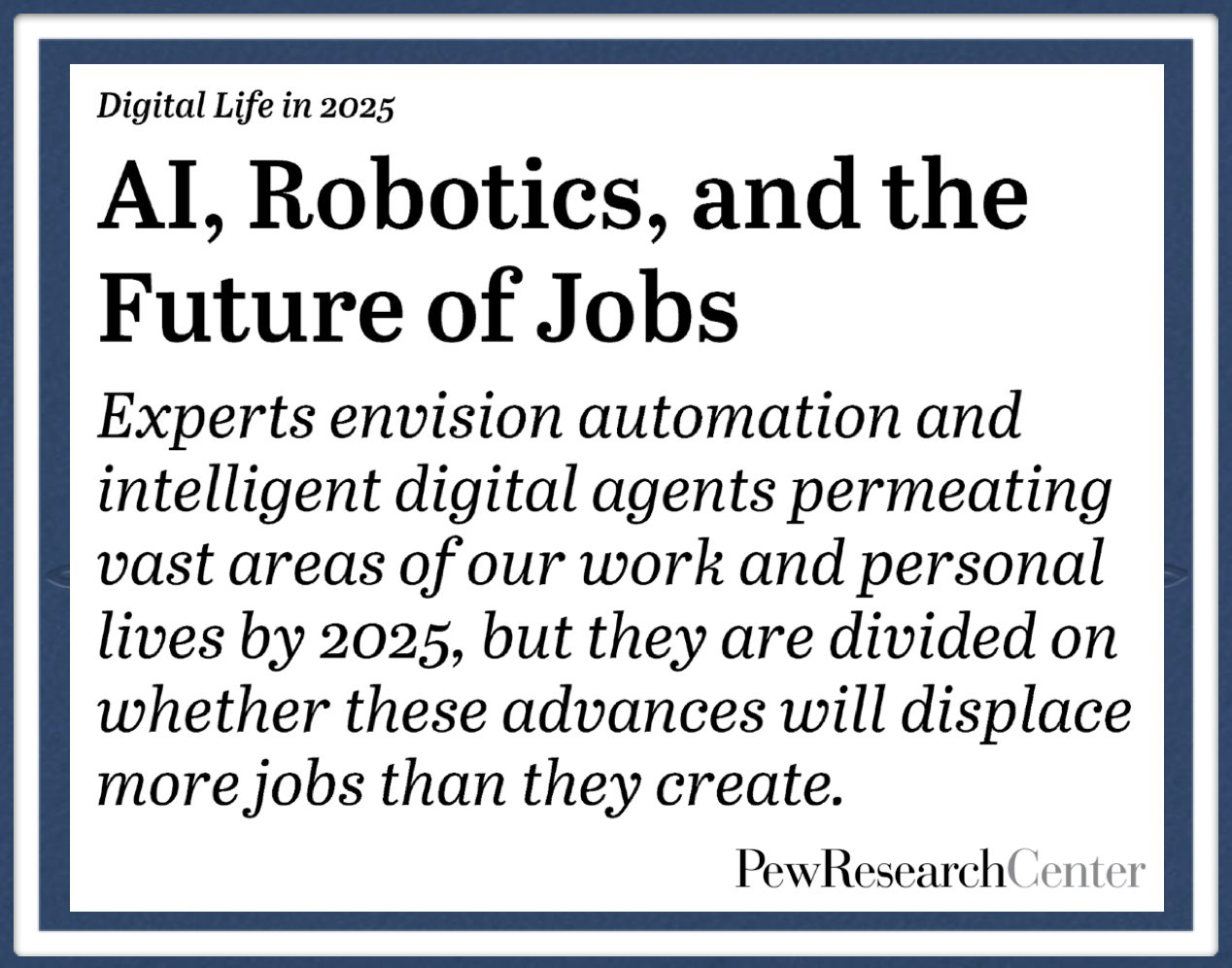 While our primary home will remain here MSU Law, Mike Bommarito and I are excited to be joining up with the good folks at CodeX – Stanford Center for Legal Informatics. Based upon our shared interests, we plan to work together on some joint research activities with some of the many talented individuals in the Stanford CodeX ecosystem. I will be joining CodeX as an External Affiliated Faculty and Mike will be joining as a CodeX Fellow. We are very excited to push forward together in the short, medium and long term!
While our primary home will remain here MSU Law, Mike Bommarito and I are excited to be joining up with the good folks at CodeX – Stanford Center for Legal Informatics. Based upon our shared interests, we plan to work together on some joint research activities with some of the many talented individuals in the Stanford CodeX ecosystem. I will be joining CodeX as an External Affiliated Faculty and Mike will be joining as a CodeX Fellow. We are very excited to push forward together in the short, medium and long term!
Tag: artificial intelligence and law
Innovation and Emerging Legal Technology (Slides by Ron Dolin from Stanford Center on the Legal Profession)
This past Thursday Ron Dolin and I spole on a panel at the 19th Annual Thomson Reuters Legal Executive Institute Law Firm Leaders Forum. Above are Ron’s slides which many of you might find interesting. Below is a modified version of my presentation Five Observations Regarding Technology and the Legal Industry (which I gave at the LegalWeek Corporate Counsel Forum last month).
Thanks to Ralph Baxter (Chairman Emeritus @ Orrick) for inviting me to present to this extremely accomplished group of AMLaw 200 managing partners.
Law is Code: A Software Engineering Approach to Analyzing the United States Code
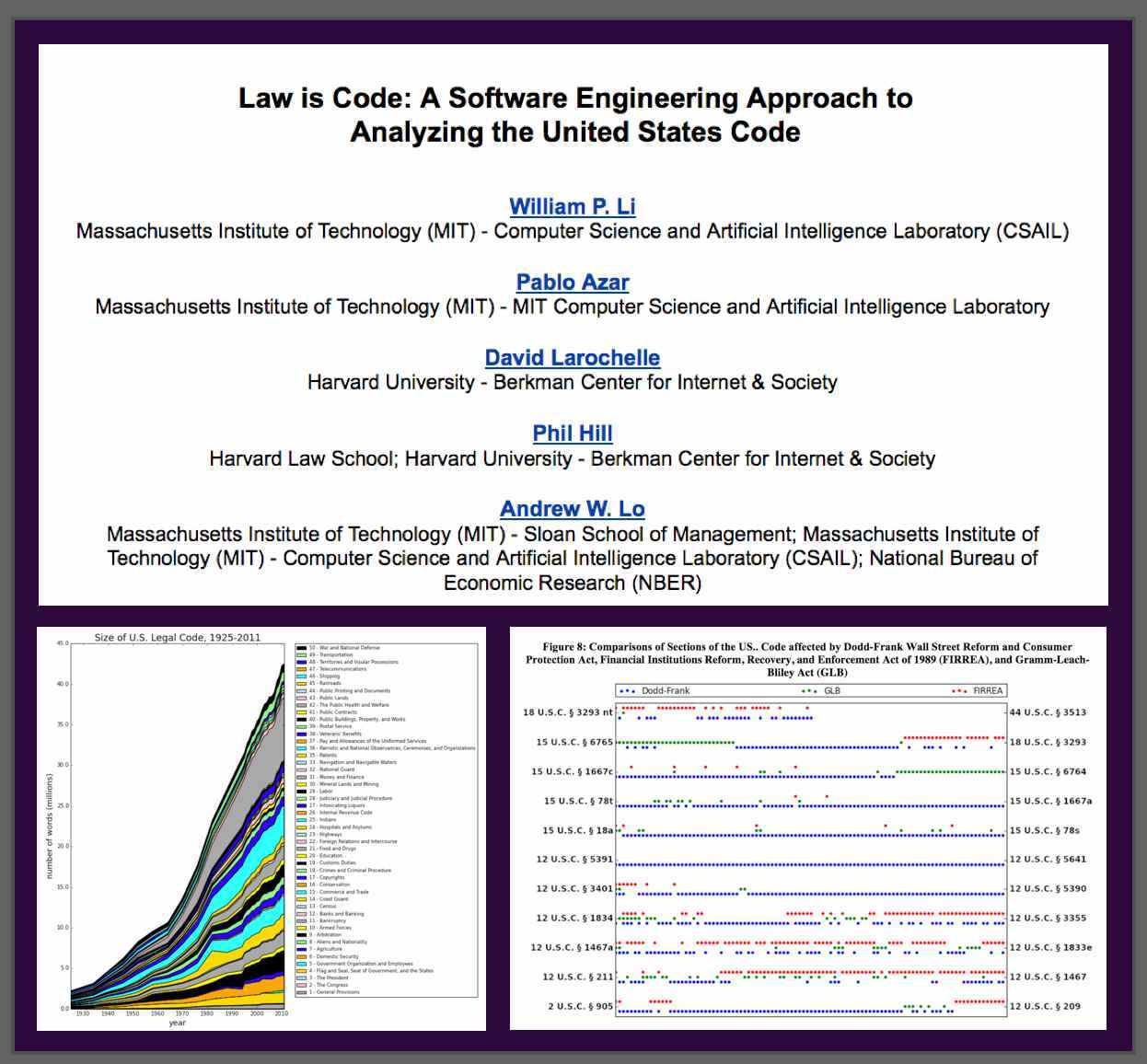 William Li, Pablo Azar, David Larochelle, Phil Hill & Andrew Lo, Law is Code: A Software Engineering Approach to Analyzing the United States Code
William Li, Pablo Azar, David Larochelle, Phil Hill & Andrew Lo, Law is Code: A Software Engineering Approach to Analyzing the United States Code
ABSTRACT: “The agglomeration of rules and regulations over time has produced a body of legal code that no single individual can fully comprehend. This complexity produces inefficiencies, makes the processes of understanding and changing the law difficult, and frustrates the fundamental principle that the law should provide fair notice to the governed. In this article, we take a quantitative, unbiased, and software-engineering approach to analyze the evolution of the United States Code from 1926 to today. Software engineers frequently face the challenge of understanding and managing large, structured collections of instructions, directives, and conditional statements, and we adapt and apply their techniques to the U.S. Code over time. Our work produces insights into the structure of the U.S. Code as a whole, its strengths and vulnerabilities, and new ways of thinking about individual laws. For example, we identify the first appearance and spread of important terms in the U.S. Code like “whistleblower” and “privacy.” We also analyze and visualize the network structure of certain substantial reforms, including the Patient Protection and Affordable Care Act (PPACA) and the Dodd-Frank Wall Street Reform and Consumer Protection Act, and show how the interconnections of references can increase complexity and create the potential for unintended consequences. Our work is a timely illustration of computational approaches to law as the legal profession embraces technology for scholarship, to increase efficiency, and to improve access to justice.”
Mike and I are excited to see this paper as it is related to two of our prior papers:
Daniel Martin Katz & Michael J. Bommarito II, Measuring the Complexity of the Law: The United States Code, 22 Journal of Artificial Intelligence & Law 1 (2014)
Michael J. Bommarito II & Daniel Martin Katz , A Mathematical Approach to the Study of the United States Code, 389 Physica A 4195 (2010)
The MIT School of Law? A Perspective on Legal Education in the 21st Century (Forthcoming in Illinois Law Review)
 ABSTRACT: “Despite some of the blustery rhetoric attendant to the ongoing market transition, lawyers and the market for legal services are not going away. Lawyers serve integral roles in a wide variety of social and political systems. Their work supports the proper functioning of markets and helps individuals and organizations vindicate their respective rights. At the same time, the processes associated with completing their work—as well as the contours of their respective expertise and judgment—are already changing. These changes are being driven by a number of economic and technological trends, many of which Larry Ribstein identified in a series of important articles published in the years before his untimely death.
ABSTRACT: “Despite some of the blustery rhetoric attendant to the ongoing market transition, lawyers and the market for legal services are not going away. Lawyers serve integral roles in a wide variety of social and political systems. Their work supports the proper functioning of markets and helps individuals and organizations vindicate their respective rights. At the same time, the processes associated with completing their work—as well as the contours of their respective expertise and judgment—are already changing. These changes are being driven by a number of economic and technological trends, many of which Larry Ribstein identified in a series of important articles published in the years before his untimely death.
This Essay is offered as part of a symposium honoring the work of the late Larry Ribstein. It is a thought exercise about a hypothetical MIT School of Law—an institution with the type of curriculum that might help prepare students to have the appropriate level of substantive legal expertise and other useful skills that will allow them to deliver value to their clients as well as develop and administer the rules governing markets, politics, and society as we move further into the 21st Century. It is a blueprint based upon the best available information, and like any other plan of action would need to be modified to take stock of shifting realities over time. It is not a solution for all of legal education. Instead, it is a targeted description of an institution and its substantive content that could compete very favorably in the existing and future market. It is a depiction of an institution whose students would arguably be in high demand. It is a high-level sketch of an institution that would be substantively relevant, appropriately practical, theoretically rigorous and world class.
Part I offers an introduction to the question. Part II sets the stage by highlighting several recent trends in the market for legal services. Taking stock of those trends, Part III highlights an alternative paradigm for legal education and describes the polytechnic style of legal education that students might obtain at an MIT School of Law. Part IV carries through on that basic thought experiment by describing the process of attracting, training, and placing students that would occur at MIT Law. Part V provides some concluding thoughts.”
Available at: Daniel Martin Katz, The MIT School of Law: A Perspective on Legal Education in the 21st Century, 2014 Illinois L. Rev (Forthcoming)
The Utility of Text: The Case of Amicus Briefs and the Supreme Court (by Yanchuan Sim, Bryan Routledge & Noah A. Smith)
 From the Abstract: “We explore the idea that authoring a piece of text is an act of maximizing one’s expected utility. To make this idea concrete, we consider the societally important decisions of the Supreme Court of the United States. Extensive past work in quantitative political science provides a framework for empirically modeling the decisions of justices and how they relate to text. We incorporate into such a model texts authored by amici curiae (“friends of the court” separate from the litigants) who seek to weigh in on the decision, then explicitly model their goals in a random utility model. We demonstrate the benefits of this approach in improved vote prediction and the ability to perform counterfactual analysis. (HT: R.C. Richards from Legal Informatics Blog)
From the Abstract: “We explore the idea that authoring a piece of text is an act of maximizing one’s expected utility. To make this idea concrete, we consider the societally important decisions of the Supreme Court of the United States. Extensive past work in quantitative political science provides a framework for empirically modeling the decisions of justices and how they relate to text. We incorporate into such a model texts authored by amici curiae (“friends of the court” separate from the litigants) who seek to weigh in on the decision, then explicitly model their goals in a random utility model. We demonstrate the benefits of this approach in improved vote prediction and the ability to perform counterfactual analysis. (HT: R.C. Richards from Legal Informatics Blog)
Five Observations Regarding Technology and the Legal Industry – My Keynote Presentation at Legal Week Global Corporate Counsel Forum – NYC 2014
It has been an exciting few days here in NYC as I was able to speak at the Legal Week Global Corporate Counsel Forum and also attend part of the IBM Watson launch at 51 Astor Place in NYC.
10 Predictions About How IBM’s Watson Will Impact the Legal Profession
I enjoyed collaborating with Paul Lippe for this short article in the ABA Journal New Normal column. We make 10 predictions about Watson’s application into the legal industry (some short term and some longer term) and preview some of our specific collaboration applying IBM Watson in the legal industry. Suffice to say there is much more to come …
Law Under the Data Deluge
Examples Law + Society as well as the Future of the Legal Profession including work by {Dazza Greenword @ MIT Media Lab, Us (i.e. Mike Bommarito and Dan Katz)} as well as many others …
Law 2050 – A Forum about the Legal Future (via JB Ruhl @ Vanderbilt Law)
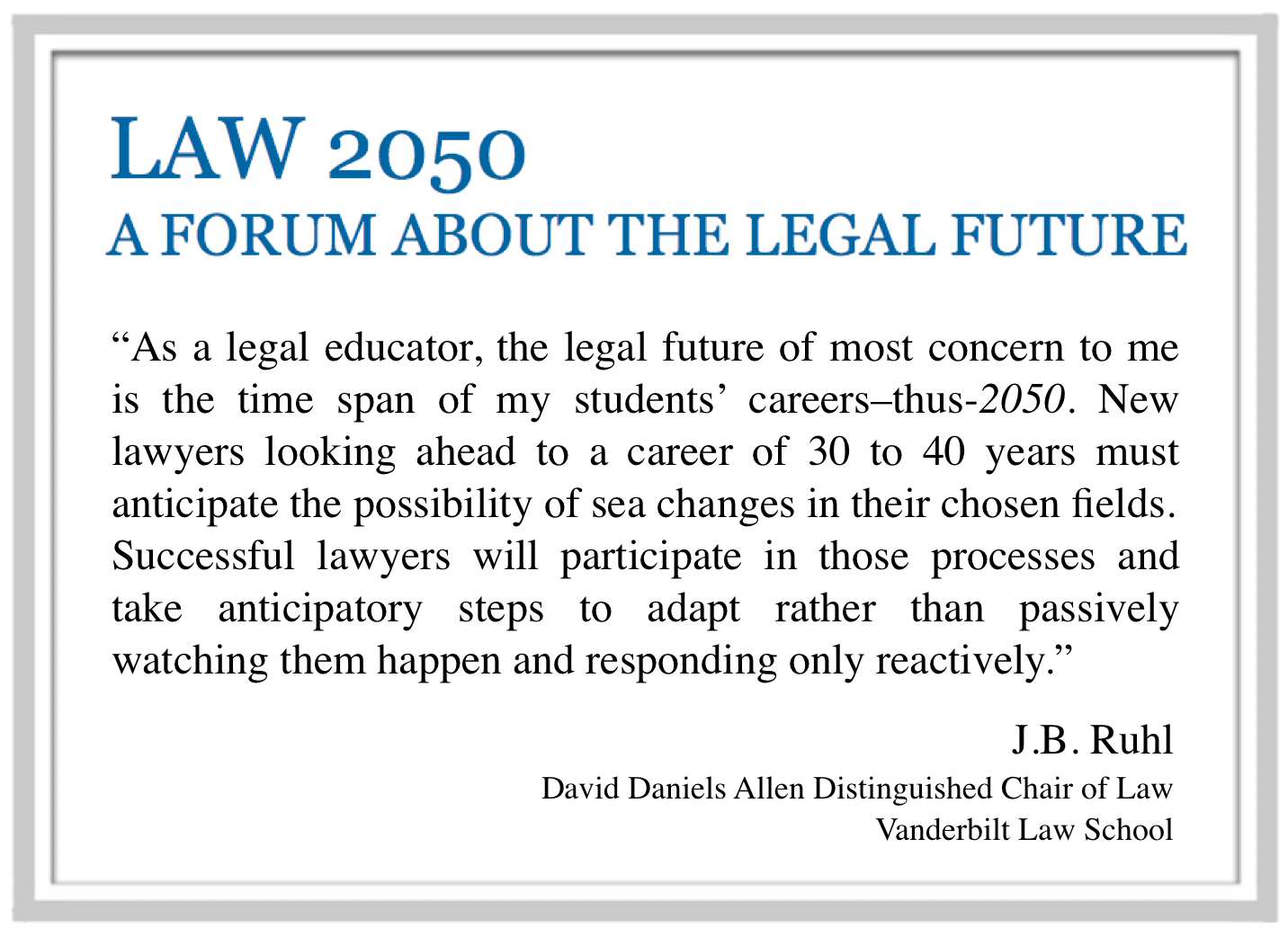 Law 2050 is a blog operated by J.B. Ruhl from Vanderbilt Law School in conjunction with his course on legal futurism offered to 2L + 3L students @ Vandy. There are two major classes of legal futurism and J.B.’s course does a nice of covering both.
Law 2050 is a blog operated by J.B. Ruhl from Vanderbilt Law School in conjunction with his course on legal futurism offered to 2L + 3L students @ Vandy. There are two major classes of legal futurism and J.B.’s course does a nice of covering both.
First, there are changes in the world that require lawyers, judges, lawmakers, etc. to develop new legal rules to take stock of shifting realities over time. Driverless cars and drones, 3-D printing, the internet of things, humans living until age 120, climate change, augmented reality and many other related innovations/developments will transform society. Law schools must produce agile and creative lawyers who can craft appropriate solutions to these developments (as they come online). Lawyers who are able to operate in such ever changing environments are the true value creators whose bespoke expertise will *never* be subjected to automation, etc.
Changes in way the lawyer work is the other class of changes for which we must prepare our students. Technology, design thinking, process engineering (lean six sigma, etc.), analytics, outsourcing, etc. have already changed and will continue to modify the legal production function. Law’s information revolution will continue to unfold and creep up the value chain. Organizing / managing / participating in this unfolding dynamic is also a form of bespoke activity. Unfortunately for many students at many schools, it has received very little (typically zero) curricular coverage (with MSU (and Vandy) excluded).
Students in J.B. Ruhl’s Law 2050 course are extremely lucky as they get the opportunity — while in law school — to consider how they fit into one or both of these forms of legal futurism.
Author Mentoring Program @ 15th International Conference on Artificial Intelligence & Law (ICAIL 2015)
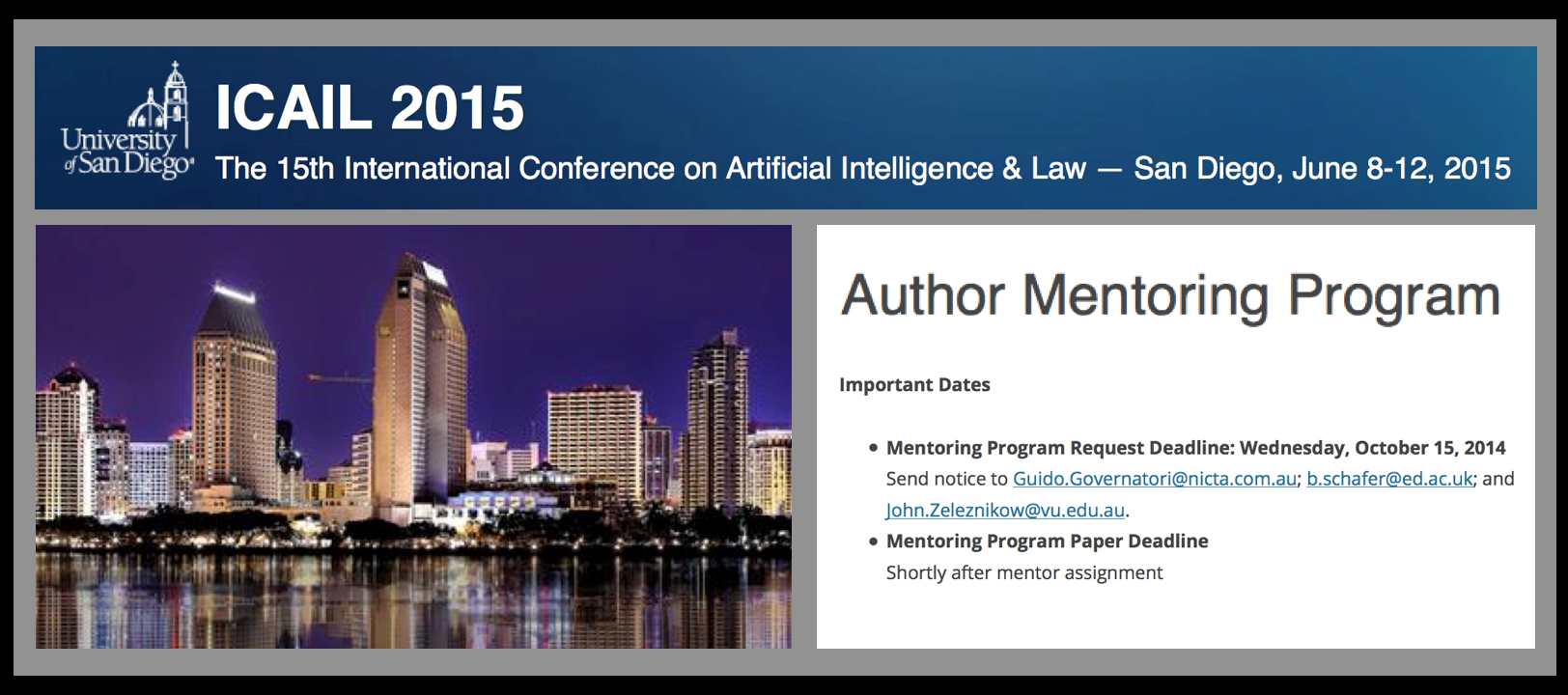 The International Association of Artificial Intelligence and Law (IAAIL) is offering a mentoring program for papers being submitted to its biennial ICAIL conference, the International Conference on Artificial Intelligence and Law. The program is intended primarily for junior authors who have not previously published an Artificial Intelligence and Law paper at a conference or in a journal. If you would like help with your submission, you may ask for a mentor ― a person who will help you with your submission to the IAAIL audience through one-on-one advising, usually via e-mail. A mentor can also familiarize you with the standards and deadlines of ICAIL submissions. Mentors are volunteers familiar with successful submissions. To request a mentor, please contact us by the Mentoring Program Request Deadline.
The International Association of Artificial Intelligence and Law (IAAIL) is offering a mentoring program for papers being submitted to its biennial ICAIL conference, the International Conference on Artificial Intelligence and Law. The program is intended primarily for junior authors who have not previously published an Artificial Intelligence and Law paper at a conference or in a journal. If you would like help with your submission, you may ask for a mentor ― a person who will help you with your submission to the IAAIL audience through one-on-one advising, usually via e-mail. A mentor can also familiarize you with the standards and deadlines of ICAIL submissions. Mentors are volunteers familiar with successful submissions. To request a mentor, please contact us by the Mentoring Program Request Deadline.
This Computer Program Can Predict 7 out of 10 Supreme Court Decisions (via Vox.com)
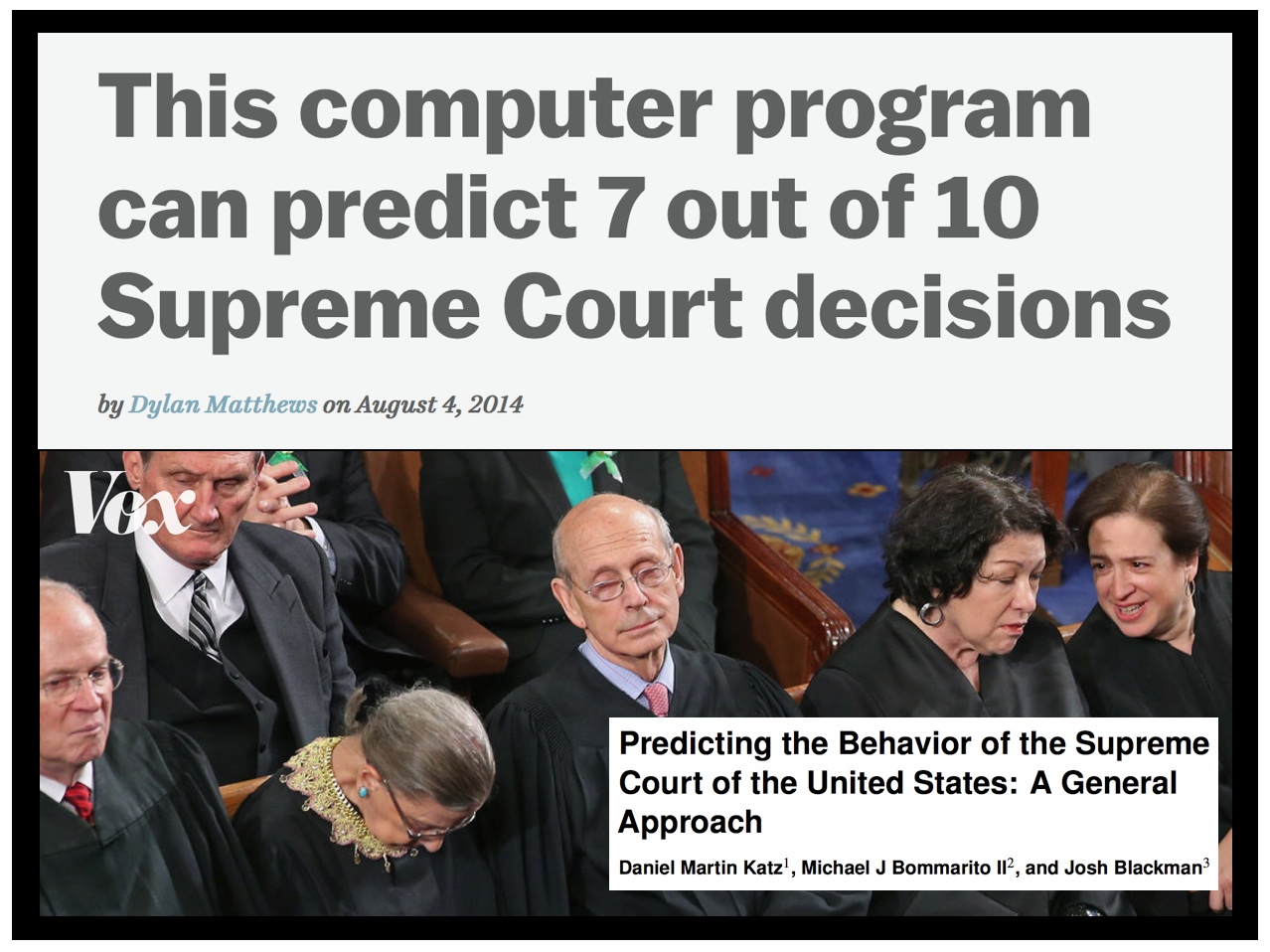 The story is here. Full form interview with Mike + Josh is here. (I unfortunately could not participate because I was teaching my ICPSR class). Our paper is available on SSRN and on the physics arXiv.
The story is here. Full form interview with Mike + Josh is here. (I unfortunately could not participate because I was teaching my ICPSR class). Our paper is available on SSRN and on the physics arXiv.
This is Law School? Socrates Takes a Back Seat to Business and Tech (via New York Times)
 Nice coverage of our efforts at MSU Law to inject our students with important skills that can be competitive differentiator in this difficult legal marketplace. As Dan Rodriguez described it – one sweet spot for differentiation is located somewhere in and around “the law/business/technology interface.” I completely agree. While it is far from the only mission, there is arbitrage located in this sweet spot because many law schools do not have faculty with the appropriate technical skills necessary to teach in this space (see also a lack of desire/vision). This creates room for others. I outlined all of this in some detail in my Keynote Address at the Stanford CodeX Conference last year (and in the forthcoming paper called “The MIT School of Law“). As MSU Law Dean Joan Howarth said “[L]egal education has been stronger on tradition than innovation …. What we’re trying to do is educate lawyers for the future, not the past.” Well said! I joined the faculty at MSU three years ago with the goal doing the very things that are now up and running – however – there is always more to do – so stay tuned for more.
Nice coverage of our efforts at MSU Law to inject our students with important skills that can be competitive differentiator in this difficult legal marketplace. As Dan Rodriguez described it – one sweet spot for differentiation is located somewhere in and around “the law/business/technology interface.” I completely agree. While it is far from the only mission, there is arbitrage located in this sweet spot because many law schools do not have faculty with the appropriate technical skills necessary to teach in this space (see also a lack of desire/vision). This creates room for others. I outlined all of this in some detail in my Keynote Address at the Stanford CodeX Conference last year (and in the forthcoming paper called “The MIT School of Law“). As MSU Law Dean Joan Howarth said “[L]egal education has been stronger on tradition than innovation …. What we’re trying to do is educate lawyers for the future, not the past.” Well said! I joined the faculty at MSU three years ago with the goal doing the very things that are now up and running – however – there is always more to do – so stay tuned for more.



